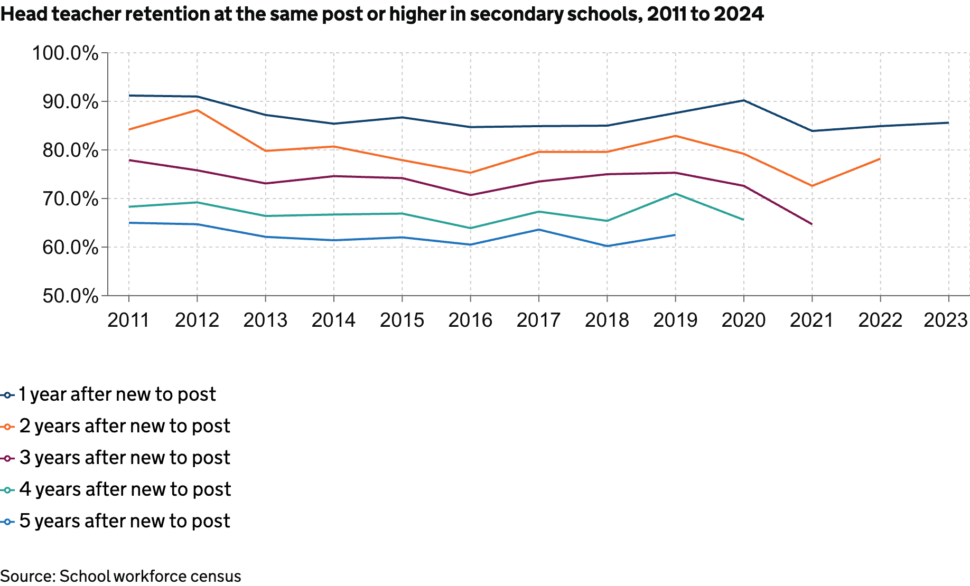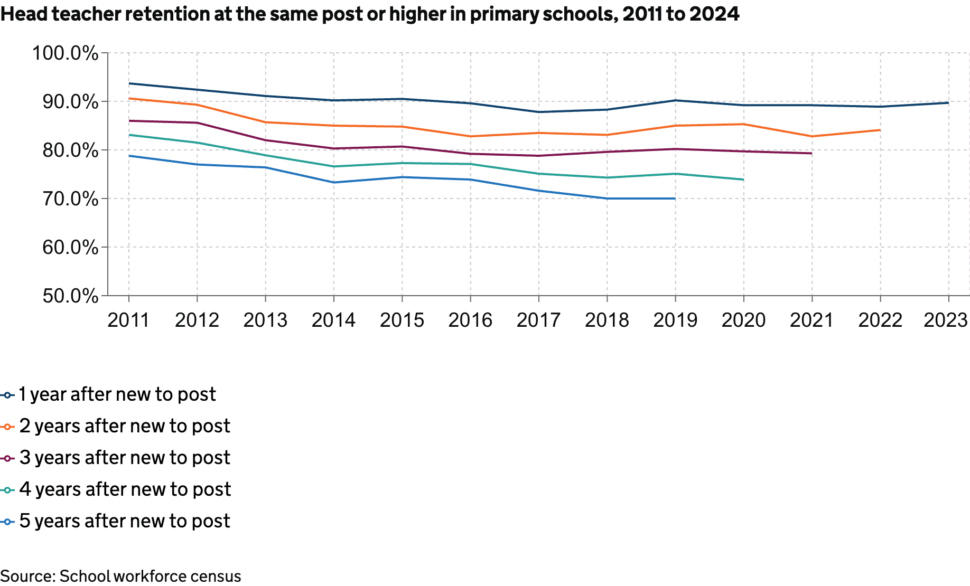A third of secondary headteachers now leave their roles within three years of appointment, new government retention analysis shows.
The data also shows that heads are also less likely than before to remain in place after four years, but slightly more likely to stay for one or two years.
The Department for Education has published data showing the proportion of leaders who started in their post between 2019 and 2023 who were still in that post, or a more senior one, in 2024.
However, one caveat from the DfE is that its workforce census data does not cover leaders centrally employed by trusts, so those moving from leadership to one of those roles would also count as not “retained”.
Exploratory analysis of teacher pension scheme data “suggests that the number of headteachers still in service but not being reported in the school workforce census has been increasing in recent years, substantially impacting the trends seen in this release”.
Here’s what we learned…
1. 1 in 3 secondary heads leave role within three years
The latest data shows just 64.7 per cent of secondary headteachers who started their role in 2021 remained in that post or a more senior one three years later.
That figure is down from 72.6 per cent among those who started in 2020, and is the lowest since current records began in 2011.
It means 35.3 per cent of heads appointed in 2021 either stepped down or were promoted to a trust role within three years.
There was also a drop in four-year retention, but a slight uptick in those staying for five years.

Secondary data also shows an increase in one-year retention (84.9 to 85.6 per cent) and a sharp rise in two-year retention (72.6 to 78.2 per cent), albeit after a sharp drop among those who started in 2021.
Of primary heads who started in 2023, 89.7 per cent were still in their post, or a higher one, after a year. This is up from 88.9 per cent among those who started in 2022.
There was also a small improvement in the proportion of primary heads in post after two years, but small decreases in the proportion staying for three or four years, and no change at five years.

2. Primary heads more likely to stick around
The latest figures, based on the 2024 school workforce census, show primary school leaders continue to have better retention than secondaries.
Primary heads were more likely than secondary heads to be in post one, three and five years after starting.
Three-year retention was 79.3 per cent among primary heads, but 64.7 per cent among secondary leaders.
3. Retention still below 2010 levels
The DfE said overall retention rates at the same post or higher in state schools had “declined since 2010”.
Despite the slight uptick, the proportion of secondary heads in their role or a higher one after a year was 85.6 per cent in 2024, below the 91.2 per cent rate in 2011.
However, the one-year retention rate has fluctuated in the intermitting years.
During the pandemic in 2021, one-year retention among secondary heads rose to 90.2 per cent, before falling to 83.9 per cent in 2022. It has been steadily increasing in the two years since.
The proportion of secondary heads in their role or higher after two years grew more significantly in the recent data, rising by 5.6 percentage points. But again, it remains below 2010 levels.
Primary retention rates have generally been more stable.
4. Deputy head retention stable…
Retention of deputy heads at primary and secondary level has also remained relatively stable over time.
At both primary and secondary schools, almost nine in 10 remained in deputy head roles or higher after one year, and around 80 per cent were still in post after three years.
5. …but longer-term retention better at primary
But longer-term retention was significantly better among primary deputy heads, than at secondary schools.
Eight in 10 (80.3 per cent) primary school deputies remained in their post or higher after three years, compared to less than three-quarters (74.8 per cent) at secondary school.
Five years after taking on their role, more than seven in 10 (73.7 per cent) primary deputy headteachers were either still in their role or a higher one. This compares to just two-thirds (66.7) at secondary level.















Your thoughts